SUPERCHARGE YOUR ONLINE VISIBILITY! CONTACT US AND LET’S ACHIEVE EXCELLENCE TOGETHER!
In the world of Search Engine Optimization, there are plenty of KPI metrics where webmasters or SEOs invest their time. This is basically in order to build up the SEO campaign’s performance in terms of link acquisition activities. In terms of advanced link metrics, some of the familiar metrics that we know are root domains, dofollow or nofollow, link traffic, link relevance, and so forth. Here in this context, we will be discussing the linked domains.
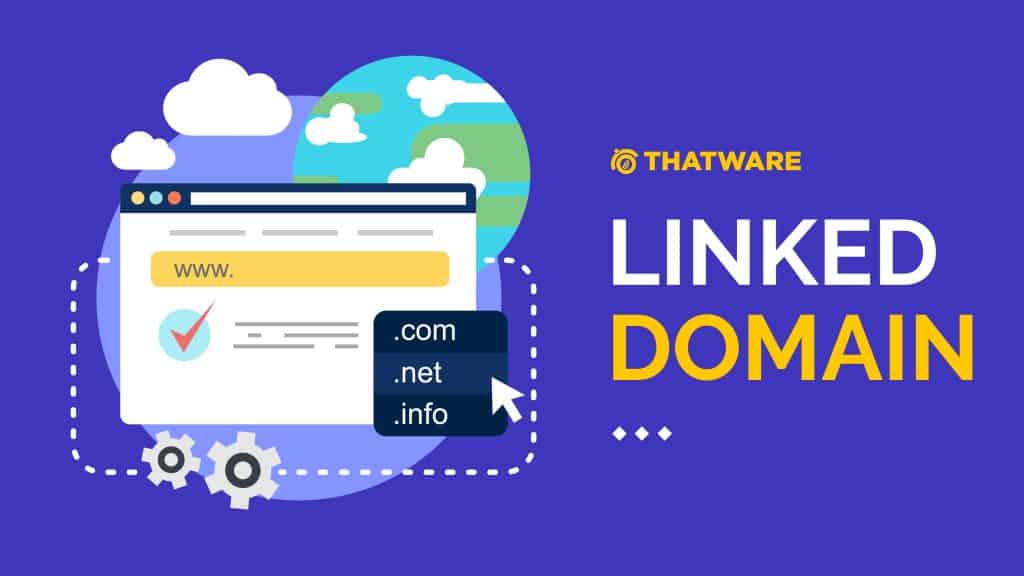
What exactly linked domain is?
Linked domains are contrary to referring domains and indicate domains that the site in question has links to (also referred to as external links):
See below reference:
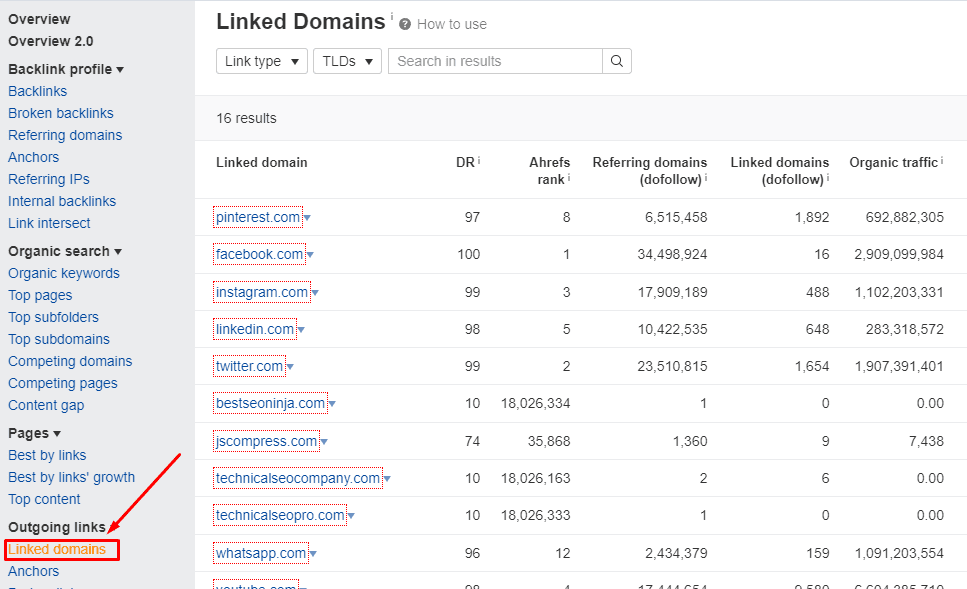
To determine the existence, one should browse through the Ahrefs tool. Then you need to go to the outgoing links segment under which you will get the desired section as shown on the above screenshot.
Sidenote: It can also be found in the Batch Analysis tool. Simply open the link below the title, and you will navigate to the section shown below:
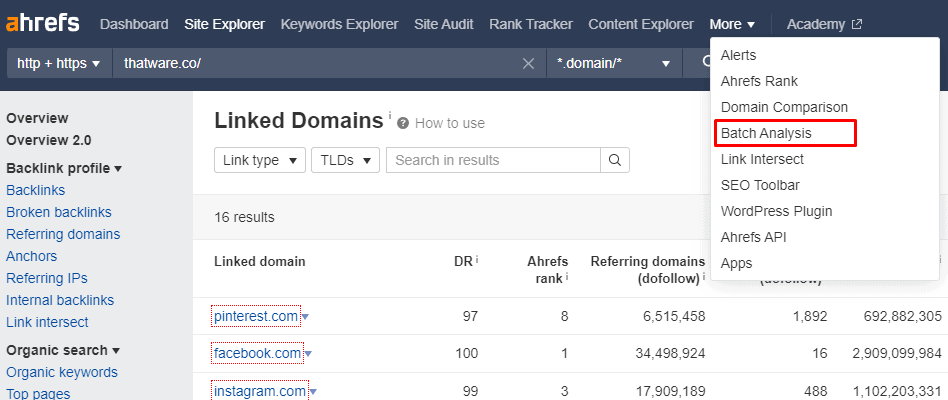
Click on the More tab, under the submenu you can see the Batch Analysis option to get started as shown here:
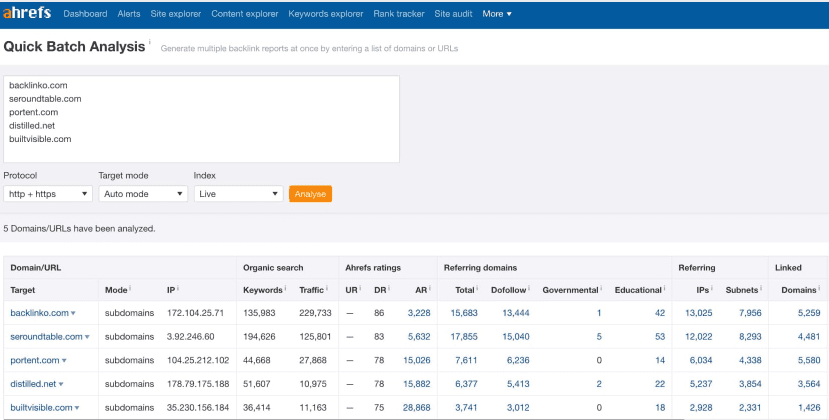
On the other hand, in Moz or SEO Spyglass tool, this term is slightly changed. The functionalities are a bit different as concerned with the respective platforms.
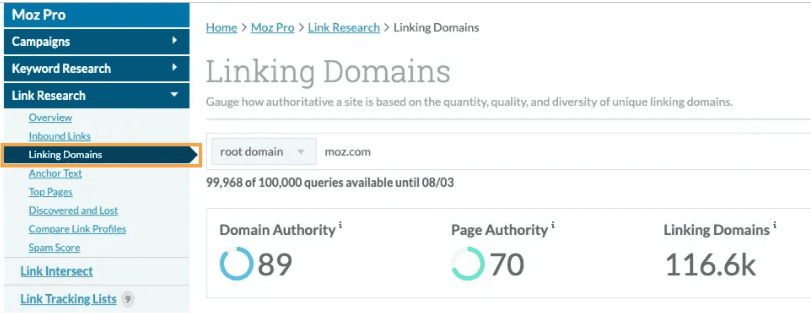
In SEO spyglass, it looks as follows:
For in-depth analysis of your backlink profile, turn to the Backlinks and Linking Domains sections under Backlink Profile in your SEO SpyGlass project.
In both segments, you’ll see the summary widget showing the number of links (except for lost or disavowed ones), a progress graph, and a link/domain type diagram. The widget can be hidden with the button below to maximize the workspace.
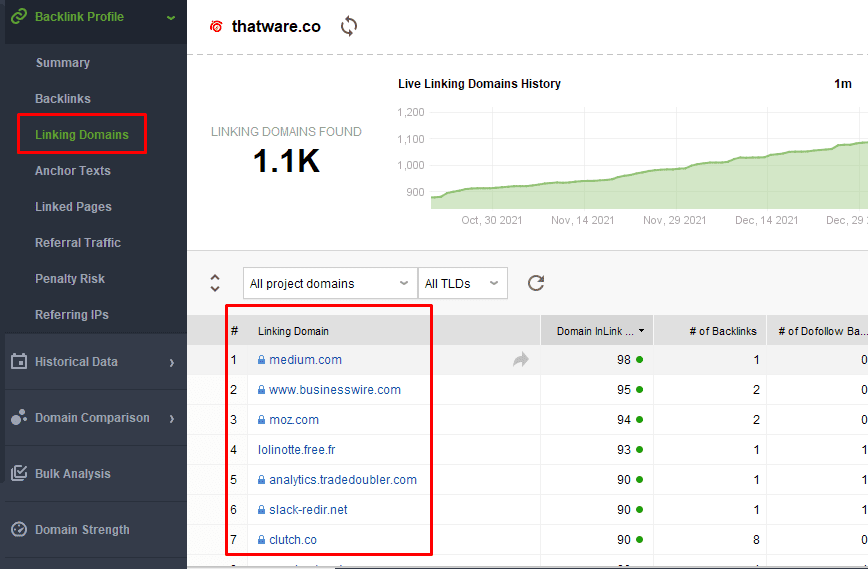
Benefits of Linked Domains
- It builds credibility for your entire link profile:
Building credibility through links enhances the overall trustworthiness of your website. Quality backlinks from reputable sources improve your link profile, signaling to search engines that your content is reliable and valuable, thereby boosting your website’s credibility in the digital space. - LD improves the trust flow for your website:
LD (Link Diversity) contributes to improving your website’s trust flow by ensuring a variety of high-quality backlinks from different sources. Search engines recognize diverse link patterns as a sign of genuine and valuable content, thus enhancing your site’s trustworthiness and credibility in search rankings. - It often leads to the overall website authority enhancement:
Acquiring high-quality links from authoritative domains strengthens your website’s overall authority. When search engines recognize that your site is linked to from trusted sources, it improves your site’s domain authority, making it more likely to rank higher in search engine results and attract more organic traffic. - These links have a longer lifespan than usual links:
Unlike standard backlinks, high-quality links often have a longer lifespan, as they are sourced from authoritative sites with sustainable reputations. These links continue to pass value over time, ensuring that your website benefits from them long after they are acquired, leading to enduring SEO advantages.
Hence building links in these links, not only help your site’s SEO performance also improves the overall website’s credibility.
How Do Linked Domains Influence SEO?
1. Enhanced Relevance and Authority
When your website is linked to by other authoritative domains, search engines view this as a vote of confidence. Each link serves as a signal that your content is valuable and relevant, thus elevating your website’s authority. Additionally, linking to relevant and reputable domains can enhance the overall user experience by providing supplementary information and resources.
2. Improved Organic Rankings
Search engines aim to deliver the most relevant and high-quality content to users. By leveraging linked domains, you increase your chances of ranking higher in search engine results pages (SERPs). When multiple reputable websites link to your domain, search engines interpret it as an indication of quality, boosting your organic rankings.
3. Increased Organic Traffic
Linking domains not only impact your rankings but also contribute to driving organic traffic to your website. When users encounter hyperlinks to your domain on other trusted websites, they are more likely to click through and explore what you have to offer. As a result, your website experiences an influx of targeted, high-quality traffic, which can lead to higher conversions and engagement rates.
4. Expanded Reach and Exposure
A strong network of linked domains can significantly expand your online reach and visibility. When your website is referenced and linked on other relevant websites, you tap into their existing audience, exposing your brand to a wider demographic. This exposure can lead to increased brand awareness, user engagement, and the potential for valuable collaborations and partnerships.
FAQs about Linked Domains
Q1: How do I find potential linked domains to connect with?
A1: Start by conducting thorough research within your industry or niche. Look for reputable websites, blogs, and online communities that share similar interests or topics as your own. Reach out to these entities and propose a mutually beneficial partnership where you can exchange links and provide valuable resources to each other’s audience.
Q2: Can linking to unrelated domains negatively affect my SEO?
A2: While linking to unrelated domains won’t directly harm your SEO, it’s crucial to maintain relevancy and quality in your link profile. Search engines prioritize natural and organic link-building practices. If you excessively link to unrelated or low-quality websites, it may raise red flags and potentially impact your website’s credibility and rankings.
Q3: Should I focus solely on external linked domains or internal linking as well?
A3: Both external and internal linked domains are essential for a well-rounded SEO strategy. External linking establishes connections with other authoritative websites, while internal linking enhances user navigation and information flow.
Best Practices for Linked Domains
Following best practices when managing your website’s linked domains is essential to improving your website’s visibility and credibility. Here is a summary of the most important practices to remember:
Quality over Quantity
Instead of focusing only on the number of backlinks, prioritize the quality of the sites linking to your site. A few high-quality, authoritative links regarding the root domain metrics from reliable sources are more important than a bunch of links from low-quality or spammy sites. Quality links can positively affect the search engine ranking and authority of your website.
The Importance of Relevant Links
Make sure the sites linking to your site are relevant to your niche or industry. Relevant links show search engines that your site is an authority on its topic. Look for links from sites with similar themes, topics, or audience demographics to maximize relevance and impact.
Anchor Text Optimization
The clickable text that gets hyperlinked in the blog plays a crucial role in boosting the SEO of any brand. Hence, you should optimize the anchor text with the help of descriptive keywords that reflect the content of the linked page. Avoid common phrases like “click here” and instead use relevant keywords that affect the context and relevance of the link.
Avoiding Black Hat Techniques
Avoid unethical or manipulative tactics to artificially increase your site’s link traffic. Black hat techniques like link buying, link farming, or keyword stuffing can lead to search engine penalties and damage your site’s reputation. Focus on organic link-building strategies that prioritize relevance, quality, and user experience.
Link Monitoring and Maintenance
Regularly monitor your site’s link profile to identify broken or toxic links that may be harming your SEO efforts. Use tools like Google Search Console, Ahrefs, or Moz to track new links, analyze their quality, and quickly troubleshoot. Additionally, regularly review existing links to ensure they are relevant and valuable. Consider having webmasters update or remove outdated or irrelevant links.
By following these best practices, you can effectively manage your linked domains to improve your site’s visibility, authority, and SEO performance. Prioritize quality over quantity, develop relevant links, optimize anchor text, avoid black hat techniques, and carefully monitor and maintain your link profile to maximize the benefits of your site.
Tools for Managing Linked Domains
Linked Domain Management requires robust tools to effectively analyze, build, and monitor your website’s backlink profile. Here are some essential tools for managing linked domains:
SEO Analysis Tools
SEMrush
SEMrush offers a comprehensive set of SEO tools, including backlink analysis capabilities. With SEMrush, you can analyze your website’s backlink profile, check your competitors’ links, and identify new link-building opportunities. In addition, SEMrush provides information on the distribution of anchor texts, referring domains, and authority.
Ahrefs
Ahrefs is another powerful SEO tool known for its link analysis capabilities. Ahrefs allows you to perform in-depth backlink audits, track backlink growth over time, and identify potential link-building opportunities. Ahrefs also provides valuable metrics such as Domain Rating (DR) and URL Rating (UR) to evaluate linking domains.
Link building tools
Moz
Moz offers a variety of tools for link building and backlink analysis. With Mozi’s Link Explorer, you can analyze your backlink profile, track link growth, and find link-building opportunities. With this Moz provides a link intersect feature which helps in identifying the sites that get linked to competitors’ sides and allows the users to search more.
Majestic
Majestic is a popular backlink analysis and link-finding tool. Majestic allows you to examine your link profile, analyze link metrics, and conduct competitive research. Majestic’s Trust Flow and Citation Flow metrics provide insight into the quality and quantity of backlinks.
Google Search Console and Bing Webmaster Tools
Google Search Console
Google Search Console is a free tool from Google that allows webmasters to monitor and manage their site’s visibility in Google search results. In Google Search Console, you can view your site’s link profile, identify link domains, and correct manual actions or issues affecting your links.
Bing Webmaster Tools
Bing Webmaster Tools offers similar functionality to Google Search Console but focuses on monitoring your site’s performance in Bing and Yahoo search results. Bing Webmaster Tools allows you to analyze your link profile, submit sitemaps, and receive notifications about potential issues that may affect your site’s visibility. It will be great from the perspective of the root domain metrics.
Using these tools, you can effectively manage your linked domains, analyze your link profile, identify link-building opportunities, and ensure your site’s performance and search engine results.
Advanced Strategies for Leveraging Linked Domains for SEO
While the basics of linked domains and their benefits have been explored, to fully harness their power, a more advanced approach is needed. These strategies focus on optimizing your link-building practices, improving the quality of linked domains, and adapting your approach to stay ahead of the competition. Let’s dive deeper into some advanced tactics that can supercharge your website’s SEO through linked domains.
1. Building Relationships with High-Authority Websites
The first step in securing valuable linked domains is establishing strong relationships with high-authority websites within your niche. When you earn backlinks from well-established sources, it signals to search engines that your content is credible and trustworthy. Building these relationships takes time, but the rewards are long-lasting.
How to Build Relationships:
- Outreach Campaigns: Personalized email outreach is still one of the most effective ways to acquire backlinks. Craft compelling messages explaining why your content is relevant to their audience and how linking to your site can offer value. Be sure to tailor each email to the recipient to avoid being flagged as spam.
- Guest Blogging: Writing guest posts on high-authority sites is a great way to gain backlinks. Ensure the blog is relevant to your niche and offers real value to readers. High-quality guest posts can enhance your credibility and offer lasting link opportunities.
- Social Media Engagement: Regularly engage with influencers and thought leaders in your industry on social media. By commenting on posts, sharing content, and offering insights, you increase your chances of being noticed, and possibly earning a link back to your website.
2. Competitor Backlink Analysis
Analyzing your competitors’ backlinks is a strategic way to find high-quality linked domains that you may have missed. By identifying domains linking to your competitors, you can pinpoint potential opportunities and strengthen your link profile. This approach helps you not only mimic your competitors’ link-building efforts but also find untapped sources for new backlinks.
How to Conduct Competitor Backlink Analysis:
- Use SEO Tools: Platforms like Ahrefs, SEMrush, and Moz allow you to analyze your competitors’ backlink profiles. Look for domains that are linking to multiple competitors, as these sites are likely to be authoritative and relevant to your niche.
- Check Link Type: Assess the type of links that your competitors are acquiring—whether they are dofollow, nofollow, or from social media platforms. This helps you understand what types of links are driving traffic and ranking power.
- Gap Analysis: Tools like Ahrefs’ “Content Gap” feature allow you to identify keywords and backlinks that your competitors are targeting, but which you may not yet be pursuing. Filling these gaps is crucial for gaining competitive advantage.
3. Linking to Relevant and Engaging Content
While external linked domains are essential for SEO, the quality of the content you link to is equally important. Linking to high-quality, relevant, and engaging content not only improves your website’s SEO but also enhances user experience by providing them with useful and valuable resources.
Best Practices for Linking to Content:
- Link to Authority Content: Link to authoritative resources within your industry, such as government publications, industry reports, or top-tier news sources. These links act as trust signals for both search engines and users.
- Regularly Update Your Links: Over time, content can become outdated, and links can lead to 404 pages. Regularly monitor and update your internal and external links to ensure they are still relevant and lead to valuable resources.
- Create Evergreen Content: Publish content that remains relevant and valuable over time. Linking to this type of content increases the likelihood that it will earn long-lasting backlinks from other authoritative sites.
4. Diversifying Link Acquisition Strategies
To avoid over-optimization, it’s crucial to diversify the sources from which you acquire backlinks. Relying on a single type of link or linking from the same set of domains can appear unnatural to search engines. Diversification also helps your website appear more authoritative, as it signals that your content is valuable to a broad range of sources.
Diversification Strategies:
- Content Types: Gain links from different types of content, such as blog posts, infographics, videos, case studies, and whitepapers. Each content format offers unique opportunities for backlinks, and diversifying helps you reach a broader audience.
- Link Building from Different Channels: Seek backlinks from a mix of channels, including social media, online forums, press releases, podcasts, and industry directories. By diversifying your approach, you increase your chances of obtaining valuable backlinks from a variety of platforms.
- Anchor Text Diversity: Use varied anchor text when linking to your site. This includes branded, exact match, and partial match keywords, as well as generic terms like “click here.” A diverse anchor text profile appears more natural to search engines and can help you rank for a wider array of keywords.
5. Advanced Link Building Techniques
While traditional link-building methods such as guest posting and outreach are effective, there are also more advanced strategies that can significantly improve your link profile.
Advanced Link Building Methods:
- Broken Link Building: Identify broken links on high-authority websites within your niche and offer your own content as a replacement. This strategy helps the website owner fix a problem while simultaneously earning you a valuable backlink.
- Skyscraper Technique: Find top-performing content within your niche, create a more comprehensive and higher-quality version of that content, and then reach out to websites that linked to the original post. Offer them your superior version as a better resource for their readers.
- Resource Page Link Building: Many websites have “resources” or “useful links” pages that link out to authoritative content. Reach out to the owners of these resource pages and request that they include your website as a valuable resource.
- Influencer Link Building: Collaborate with influencers and industry leaders to create content together. Influencers can help share your content with their audience, and the collaboration often results in backlinks from their authoritative domains.
6. Utilizing Local and Niche Directories
One often overlooked aspect of linked domains is local and niche-specific directories. These directories can offer a valuable source of backlinks, especially if they are highly relevant to your industry. Submitting your site to quality local directories, such as those related to your city or region, can provide you with a niche-specific backlink that improves your site’s authority and visibility.
Directory Submission Best Practices:
- Focus on Niche Directories: Look for directories that cater to your industry or geographic location. For example, if you run a travel blog, submitting your site to travel-focused directories can improve your backlink profile.
- Ensure Directory Quality: Avoid submitting to spammy or low-quality directories, as these can harm your SEO efforts. Focus on reputable directories with strict editorial standards that only list quality websites.
- Complete Your Listing: Ensure your directory listing is complete with accurate contact information, business details, and relevant keywords. A well-optimized listing not only improves your visibility but also makes your site more appealing to potential visitors.
7. Tracking Linked Domains and Link Growth
As with any aspect of SEO, tracking the performance of your linked domains is vital. Regularly assessing the quality of your backlinks ensures that you are focusing on the right sources and optimizing your strategy.
Key Metrics to Monitor:
- Link Acquisition Rate: Monitor how quickly you’re acquiring new linked domains and the overall growth of your backlink profile. A steady, natural increase in links signals to search engines that your site is trustworthy and gaining authority.
- Link Quality: Regularly evaluate the quality of your linked domains using tools like Ahrefs and SEMrush. Look for backlinks from authoritative sites and aim to disavow any low-quality or spammy links that could harm your SEO efforts.
- Referral Traffic: Analyze how much traffic is coming to your website from linked domains. High referral traffic indicates that your backlinks are not only improving your SEO but also driving relevant visitors to your site.
Mastering Linked Domains for SEO Success
Linked domains are an integral part of SEO strategy. They improve your website’s authority, relevance, and visibility, leading to better organic rankings, higher traffic, and increased brand exposure. By leveraging advanced strategies such as competitor backlink analysis, relationship building, and diversified link acquisition, you can further enhance your site’s SEO performance. Implementing these tactics requires careful planning and consistent effort, but the results are worth it. Use the best practices, track your progress, and stay informed about the latest link-building trends to maintain an edge in the competitive online landscape.

Thatware | Founder & CEO
Tuhin is recognized across the globe for his vision to revolutionize digital transformation industry with the help of cutting-edge technology. He won bronze for India at the Stevie Awards USA as well as winning the India Business Awards, India Technology Award, Top 100 influential tech leaders from Analytics Insights, Clutch Global Front runner in digital marketing, founder of the fastest growing company in Asia by The CEO Magazine and is a TEDx speaker and BrightonSEO speaker.

